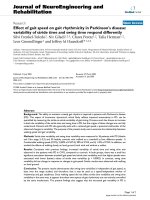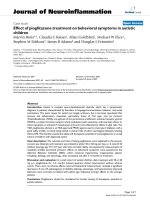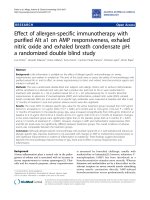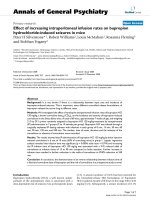Báo cáo y học: "Effect of erythropoietin therapy on clinical outcome in patients after acute ischemic stroke: a debatable issue" doc
Bạn đang xem bản rút gọn của tài liệu. Xem và tải ngay bản đầy đủ của tài liệu tại đây (103.71 KB, 2 trang )
Our recent clinical trial has shown that erythropoietin
(EPO) therapy signifi cantly increased circulating endo-
thelial progenitor cell (EPC) levels and was strongly
associated with favorable 90-day clinical outcomes after
ischemic stroke (IS) [1]. Contrary to the fi ndings of our
study [1] and of others [2,3], the randomized phase II/III
German Multicenter EPO Stroke Trial [4], which is
currently the largest clinical study on EPO treatment in
patients with IS, not only failed to show any additional
benefi t but also demonstrated increased mortality after
combined therapy with EPO and tissue plasminogen
activator (tPA) [4]. Interestingly, subgroup analysis of the
study revealed that EPO therapy improved 90-day clinical
outcome in patients without additional tPA therapy [4].
In this way, the fi ndings from the subgroup analysis of
that study [4] corroborate those of our clinical trial [1].
We thank Minnerup and colleagues [5] for their
comments in the previous issue of Critical Care. ese
authors suggested that, for evaluating 90-day neurological
outcome, the modifi ed Rankin Scale or the Barthel Index
could be superior to the National Institutes of Health
Stroke Scale (NIHSS) that was used in our study [5]. ey
also mentioned that, when the components of the
composite endpoint in our study protocol are considered,
the signifi cantly higher number of patients with an
NIHSS score of at least 8 after placebo treatment is also
likely to be caused by the high rate of recurrent strokes
and does not necessarily refl ect improved neurological
function in the EPO group [5]. However, NIHSS is widely
accepted as one of the most effi cacious tools for evalu-
ating neurological outcome after acute IS. Additionally,
the trial in our study was prospective, randomized, and
placebo-controlled – this is the best design to minimize
the selection bias between the study group and the
control group. Accordingly, we suggest that the signifi -
cantly lower number of patients with an NIHSS score of
at least 8 in the EPO group in comparison with the
placebo group could refl ect simply the therapeutic
benefi t of EPO therapy in improving the 90-day neuro-
logical outcome rather than a mere speculation of a
higher rate of recur rent strokes in the placebo group.
e optimal dosage of EPO and duration of treatment
for patients after IS remain uncertain. is may account
for some inconsistency in improvement of neurological
outcome after IS in clinical trials [1-4]. Accordingly, we
disagree with Minnerup and colleagues [5] that ‘the
potential side eff ects and the failed effi cacy in large
clinical trials will presumably prevent the use of EPO as a
therapy to increase EPCs after stroke’.
Minnerup and colleagues also underscored that the
study was fi rst assigned to a trial register (ISRCTN
96340690) in January 2011, which was 10 months after
the inclusion of the last patients in March 2010 [5]. We
would like to underscore that, in addition to receiving
institutional review board approval, our study [1] was
reviewed and approved by the National Science Council
of Taiwan before implementation. Actually, our clinical
trial started long before we applied for an assignment to a
trial registry. We believe that well-controlled studies
remain the primary bases of scientifi c progress. Further
evidence is required for solid conclusions to be made.
Abbreviations
EPC, endothelial progenitor cell; EPO, erythropoietin; NIHSS, National Institutes
of Health Stroke Scale; IS, ischemic stroke; tPA, tissue plasminogen activator.
Competing interests
The authors declare that they have no competing interests.
Authors’ contributions
C-MY and SL wrote the manuscript. H-KY and C-KS revised the manuscript. All
authors read and approved the nal manuscript.
© 2010 BioMed Central Ltd
E ect of erythropoietin therapy on clinical
outcome in patients after acute ischemic stroke:
adebatable issue
Chun-Man Yuen
1
, Cheuk-Kwan Sun
2,3
, Steve Leu
4,5
and Hon-Kan Yip*
4,5
See related research by Yip et al., and related commentary by Minnerup et al.,
/>LETTER
*Correspondence:
4
Division of Cardiology, Department of Internal Medicine, Chang Gung Memorial
Hospital - Kaohsiung Medical Center, Chang Gung University College of Medicine,
123 Ta-Pei Road, Niaosong District, Kaohsiung City, 833, Taiwan
Full list of author information is available at the end of the article
Yuen et al. Critical Care 2011, 15:425
/>© 2011 BioMed Central Ltd
Author details
1
Division of Trauma, Department of Surgery, Chang Gung Memorial Hospital-
Kaohsiung Medical Center, Chang Gung University College of Medicine,
123 Ta-Pei Road, Niaosong District, Kaohsiung City, 833, Taiwan.
2
Division of
General Surgery, Department of Surgery, Chang Gung Memorial Hospital-
Kaohsiung Medical Center, Chang Gung University College of Medicine,
123Ta-Pei Road, Niaosong District, Kaohsiung City, 833, Taiwan.
3
Department
of Emergency Medicine, E-Da Hospital, I-Shou University, Kaohsiung City,
824, Taiwan
4
Division of Cardiology, Department of Internal Medicine, Chang
Gung Memorial Hospital - Kaohsiung Medical Center, Chang Gung University
College of Medicine, 123 Ta-Pei Road, Niaosong District, Kaohsiung City, 833,
Taiwan.
5
Center for Translational Research in Biomedical Sciences, Chang
Gung Memorial Hospital - Kaohsiung Medical Center, Chang Gung University
College of Medicine, 123 Ta-Pei Road, Niaosong District, Kaohsiung City, 833,
Taiwan.
Published: 17 May 2011
References
1. Yip HK, Tsai TH, Lin HS, Chen SF, Sun CK, Leu S, Yuen CM, Tan TY, Lan MY, Liou
CW, Lu CH, Chang WN: E ect of erythropoietin on level of circulating
endothelial progenitor cells and outcome in patients after acute ischemic
stroke. Crit Care 2011, 15:R40.
2. Tseng MY, Hutchinson PJ, Richards HK, Czosnyka M, Pickard JD, Erber WN,
Brown S, Kirkpatrick PJ: Acute systemic erythropoietin therapy to reduce
delayed ischemic de cits following aneurysmal subarachnoid
hemorrhage: a Phase II randomized, double-blind, placebo-controlled
trial. Clinical article. J Neurosurg 2009, 111:171-180.
3. Ehrenreich H, Hasselblatt M, Dembowski C, Cepek L, Lewczuk P, Stiefel M,
Rustenbeck HH, Breiter N, Jacob S, Knerlich F, Bohn M, Poser W, Rüther E,
Kochen M, Gefeller O, Gleiter C, Wessel TC, De Ryck M, Itri L, Prange H, Cerami
A, Brines M, Sirén AL: Erythropoietin therapy for acute stroke is both safe
and bene cial. Mol Med 2002, 8:495-505.
4. Ehrenreich H, Weissenborn K, Prange H, Schneider D, Weimar C, Wartenberg
K, Schellinger PD, Bohn M, Becker H, Wegrzyn M, Jähnig P, Herrmann M,
Knauth M, Bähr M, Heide W, Wagner A, Schwab S, Reichmann H,
Schwendemann G, Dengler R, Kastrup A, Bartels C; EPO Stroke Trial Group:
Recombinant human erythropoietin in the treatment of acute ischemic
stroke. Stroke 2009, 40:e647-656.
5. Minnerup J, Wersching H, Schäbitz W: Erythropoietin for stroke treatment:
dead or alive? Crit Care 2011, 15:129.
doi:10.1186/cc10145
Cite this article as: Yuen C-M, et al.: E ect of erythropoietin therapy on
clinical outcome in patients after acute ischemic stroke: a debatable issue.
Critical Care 2011, 15:425.
Yuen et al. Critical Care 2011, 15:425
/>Page 2 of 2


![Báo cáo Y học: Effect of adenosine 5¢-[b,c-imido]triphosphate on myosin head domain movements Saturation transfer EPR measurements without low-power phase setting ppt](https://media.store123doc.com/images/document/14/rc/vd/medium_vdd1395606111.jpg)






